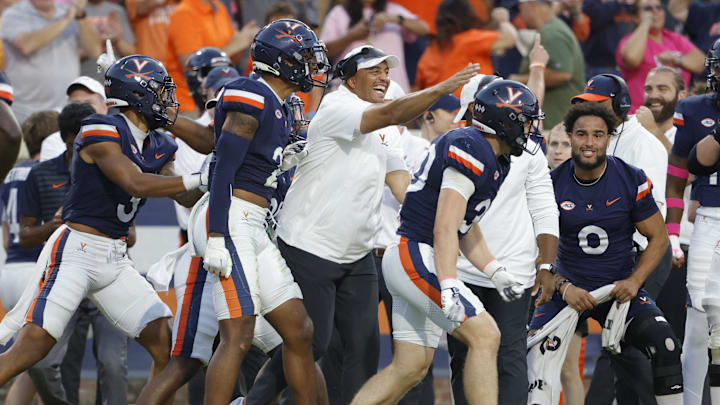Can Virginia Be This Year’s Indiana? Why they Could Be This Year's CFB Cinderella

In this story:
After seeing Indiana go from 3–9 to 11–2 and make the College Football Playoff in just one year, it’s hard not to wonder—why not Virginia? The Hoosiers made it happen with a new coaching staff, a roster full of transfers, and a schedule that gave them a real shot.
Now it’s 2025, and Virginia’s in a similar spot. The Hoos also went 3–9 last season, but they didn’t sit still. UVA brought in 31 transfers and, according to ESPN, has the most manageable Power Five schedule in the country. That puts all the pressure on head coach Tony Elliott, who still hasn’t made a bowl game in three years. This feels like the make-or-break season.
The Indiana Blueprint: From Bottom to CFP
Indiana’s transformation in 2024 began with a leadership change. Curt Cignetti arrived from James Madison and immediately infused the program with direction and discipline. The Hoosiers brought in over 30 transfers, including quarterback Kurtis Rourke from Ohio, who passed for 3,024 yards and 29 touchdowns. Defensively, as a result of top-rated transfers, Indiana ranked in the top two nationally in total defense (256.3 ypg) and sixth in scoring defense (15.6 ppg). All combined with a forgiving schedule, Indiana achieved an 11–2 record, and the school's first-ever College Football Playoff berth.
How Virginia Mirrors Indiana—and How It Doesn't
Virginia also finished 3–9 last year but responded with urgency. In the offseason, the Hoos brought in 31 transfers, the second-most in the ACC among programs without a coaching change. Virginia’s transfer class is one of the highest-rated in program history, with multiple players coming from Power Four schools. Per 247Sports, the Cavaliers' transfer average rating hovered around 0.8600, comparable to Indiana’s portal upgrades in 2024.
Defensive lineman Hunter Osborne comes from Alabama, offensive tackle Monroe Mills from Louisville, wide receiver Jahmal Edrine from Purdue, and quarterback Chandler Morris from North Texas. The offensive line has seen significant upgrades. Despite Mills suffering a spring ACL injury, additions like Kevin Wigenton II (Illinois), Tyshawn Wyatt (JMU), David Wohlabaugh Jr. (Syracuse), and Makilan Thomas (Arkansas State) provide new depth. ESPN’s Adam Rittenberg singled out the line as one of the roster’s brighter spots.
At wideout, UVA added Jayden Thomas from Notre Dame and Cam Ross from JMU to join Edrine. On defense, they’ve bolstered key areas with Mitchell Melton (Ohio State), Devin Neal (Louisville), and Emmanuel Karnley (Miami). In total, the Cavaliers have plugged gaps at nearly every position.
Similarly to Indiana, Virginia faces a similar forgiving schedule; Unlike Indiana, Virginia did not change coaches. Tony Elliott remains in charge, entering his fourth year with a career record of 11–23. The opportunities with a new quarterback, a strong transfer class, and a very winnable schedule make this a clear bowl-or-bust year for Elliott.
All Eyes on Chandler Morris
Quarterback play will be critical. With Anthony Colandrea transferring, UVA turned to Chandler Morris, who had a breakout season at North Texas in 2024. He ranked in the top five nationally in both touchdown passes (31) and passing yards per game (314.5), finishing with 3,774 total yards through the air.
Morris, who previously played at Oklahoma and TCU, chose Virginia over offers from Oklahoma State and UCF. Still, he only has one year of eligibility, and ESPN’s Future Power Rankings note Virginia lacks a long-term answer at quarterback.
The Schedule: As Favorable as It Gets
Virginia doesn’t just have talent—they have opportunity. ESPN’s Football Power Index (FPI) ranks UVA’s 2025 schedule 83rd nationally, the lowest in the Power Four. The Cavaliers avoid Clemson, Miami, SMU, and Georgia Tech. They play:
- Coastal Carolina (FPI No. 100)
- Stanford (No. 64)
- Washington State (No. 98)
- Wake Forest (No. 89)
- California (No. 60)
Virginia has no opponent ranked in the FPI top 25 and just two in the top 40. FPI projects a 71.4% chance of making a bowl, with a 7–5 record as the most likely outcome.
Still, ESPN ranks Virginia just 15th out of 17 ACC teams in their Future Power Rankings, only ahead of Stanford and Wake Forest, citing questions at quarterback longevity, line play, and overall star power.
So, Can Virginia Be This Year’s Indiana?
Structurally? Yes. Virginia has emulated Indiana’s 2024 formula: rebuild through the portal, upgrade at quarterback, and lean on a forgiving schedule.
Coaching-wise? Still uncertain. Curt Cignetti brought a winning pedigree and culture reset to Indiana. Tony Elliott, now in year four with no bowl appearances, has continuity but must prove results.
If Morris stays healthy, the line holds up, and the defense improves even marginally, Virginia could very well go 7–5 or 8–4 and reach its first bowl since 2019. If not, Elliott could be out—and Virginia will have to start over yet again.
Yes, Virginia can be this year’s Indiana—but this time, there are no excuses left. It’s prove-it time in Charlottesville.
Additional Virginia Football News:

Alexander Plonski joined Virginia Cavaliers On SI in June of 2025. He is from Limerick, Pennsylvania, and is currently a third-year student at the University of Virginia, double majoring in Government and Economics. With a strong passion for UVA sports and experience in political communication, nonprofit leadership, and student government, Alexander brings an analytical and thoughtful perspective to his writing. He covers UVA football, baseball, and various other sports.